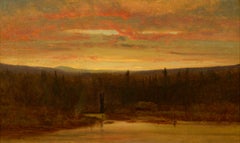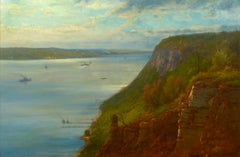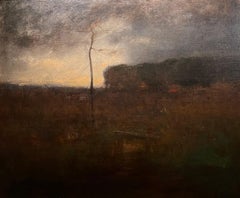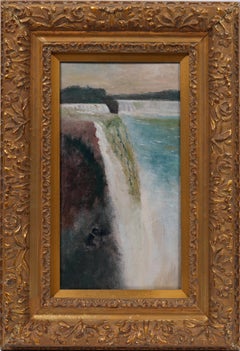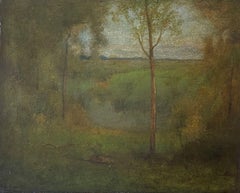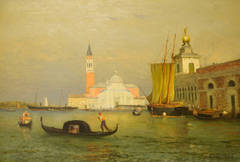George Inness Art
George Inness, one of America's foremost landscape painters of the late 19th century, was born in 1825 near Newburgh, New York. He spent most of his childhood in Newark, New Jersey. He was apprenticed to an engraving firm until 1843 when he studied art in New York with Regis Gignoux, a landscape painter from whom he learned the classical styles and techniques of the Old Masters. In 1851, sponsored by a patron, Inness made a 15-month trip to Italy. In 1853, he traveled to France, where he discovered Barbizon landscape painting, leading him to adopt style that used looser, sketchier brushwork and more open compositions, emphaa sizing the expressive qualities of nature. After working in New York from 1854–59, he moved to Medfield, Massachusetts, and four years later to New Jersey, where through a fellow painter he began to experiment with using glazes that would allow him to fill his compositions with subtle effects of light. Duncan Phillips remarked on Inness’s mellow light as a unifying force, saying, “…he was equipped to modernize the grand manner of Claude and to apply the methods of Barbizon to American subjects." At this time also, Inness developed an interest in the religious theories of Emanuel Swedenborg, an 18th-century theologian who believed that all material things were imbued with spiritual presence and who proposed a philosophy in which earthly and heavenly realms are united. Inness's paintings throughout the decade of the 1860s showed sweeping, panoramic views of the Catskills, the Delaware Valley, or the New Jersey countryside. Despite their varying locales, these scenes share a spiritual expressiveness in the portrayal of nature’s moods, for example, dramatic effects of weather and atmosphere. In Inness’s mature paintings, the forms of the landscape become indistinct, hazy, abstracted, suggesting an existence in both material and immaterial worlds. Inness moved back to New York in 1867 and in 1868 was elected to full membership in the National Academy of Design, but being an inveterate traveler, he returned to Europe in 1870, living in Rome from 1871–75. Two years later he returned to New York, where he helped found the Society of American Artists. In 1878, he settled in Montclair, New Jersey, but continued to travel and paint misty, poetic, and evocative landscapes. Over the years, he went to a variety of locations in the eastern and southern United States, and to Cuba, California and Mexico. After 1880, his late synthetic landscapes were purely conceptual, made in a studio practice that relied on the memory of actual places but was fundamentally an embodiment in paint of the artist’s deepest feelings. With these dematerialized landscapes, attuned to the Transcendentalists, Inness pioneered an essential conceptualist art, one that would find echoes in the works of the Abstract Expressionists and Color Field painters of the 20th century. In 1894, Inness made his last trip abroad, visiting France, Germany, and Scotland, where he died. A public funeral was held in New York at the National Academy, which also held a large exhibition of his paintings that same year.
19th Century Hudson River School George Inness Art
Canvas, Oil
19th Century Tonalist George Inness Art
Oil
1880s American Barbizon School Antique George Inness Art
Wood
1880s Hudson River School George Inness Art
Oil, Paint, Canvas
Early 1900s Hudson River School George Inness Art
Oil, Canvas
1890s Hudson River School George Inness Art
Canvas, Oil
1890s Tonalist George Inness Art
Canvas, Oil
Early 20th Century Hudson River School George Inness Art
Canvas, Oil
1890s Hudson River School George Inness Art
Canvas, Oil
Late 19th Century Hudson River School George Inness Art
Canvas, Oil
Mid-19th Century Hudson River School George Inness Art
Canvas, Oil
1920s Tonalist George Inness Art
Canvas, Paint, Oil
Mid-19th Century Hudson River School George Inness Art
Oil, Canvas
1910s Tonalist George Inness Art
Linen, Oil
Early 1900s Tonalist George Inness Art
Canvas, Oil
19th Century Hudson River School George Inness Art
Oil, Canvas
1880s Tonalist George Inness Art
Oil, Board
19th Century Impressionist George Inness Art
Canvas, Oil
